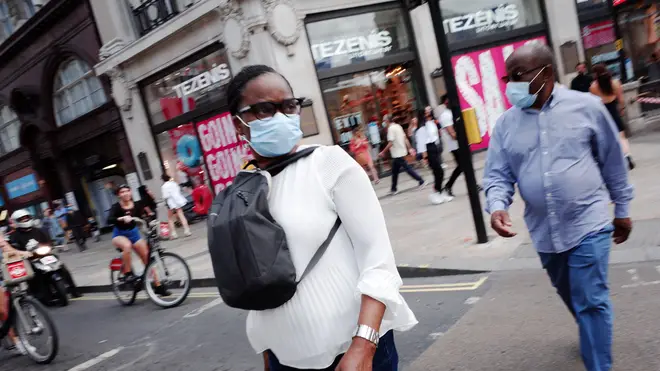
Natasha Devon 6pm - 9pm
23 July 2020, 06:22

The laws around face coverings will change in shops and supermarkets in England from Friday, but what are the new rules and why should you wear a face covering?
Under new rules coming into effect on Friday, customers will have to have their nose and mouth covered or face a fine of up to £100.
However, the regulations won't apply to everyone and some people with certain disabilities will be exempt.
The wearing of face coverings on public transport has been mandatory since June in England.
Initially, many experts and authorities, including the World Health Organisation (WHO), suggested face coverings were not effective in preventing the spread of Covid-19 but are now recommending wearing them in indoor spaces.
What will the new face-covering rules mean for you? Here's everything you need to know.
Face coverings must be worn in shops, supermarkets, indoor shopping centres and transport hubs - such as train stations and airports - in England from Friday.
A face covering is defined as a fabric covering, scarf or bandana that covers the nose and mouth.
It will be compulsory to wear a face covering when buying food and drink to takeaway from cafes and shops.
If you are in a restaurant or other venue where you are able to sit down and eat or drink, then the covering can be removed.
They will not be mandatory for anyone under the age of 11, those with disabilities or certain health conditions, such as respiratory or cognitive impairments that make it difficult for them to wear a face covering.

Shop owner says she has been blindsided by mask enforcement
Anyone who doesn’t abide by the regulations - and is not exempt under one of the categories set out in the regulations - could face a fine by the police of up to £100, as is currently the case on public transport.
The police have been very clear throughout the pandemic that they will “engage, explain, encourage and finally enforce as a last resort”.

How to make your own face mask
A report recently published by the Royal Society suggests that even basic homemade face coverings can reduce transmission if enough people wear them when in public.
The study, based on mathematical modelling, showed that if an entire population wore face coverings that were only 75% effective, it would bring the R value, which is the number of people an infected individual passes the virus on to, from 4.0 to under 1.0, without the need for lockdowns.
Another Royal Society report suggests the use of cotton masks is associated with a 54% lower odds of infection in comparison to the no mask groups, when tested in a healthcare setting.
Melinda Mills, Nuffield professor of sociology, at the University of Oxford, told a webinar: "So that should suggest that when you're generally in the public that it should offer you some, not 100%, but it does offer you some protection."
Meanwhile, another study which looked at coronavirus deaths across 198 countries found that nations which had policies favouring mask-wearing had lower death rates.
In another piece of scientific research, published in the journal Proceedings of the National Academy of Sciences last month, scientists calculated that wearing face coverings prevented more than 78,000 infections in Italy between April 6 and May 9, and more than 66,000 infections in New York City between April 17 and May 9.
Experts say the risk of coronavirus transmission appears to be higher in poorly ventilated indoor spaces and wearing face coverings in small shops or enclosed shopping centres could help reduce the spread.
Keith Neal, emeritus professor of the epidemiology of infectious diseases at the University of Nottingham, said: "Lack of strong evidence of their effectiveness should not be considered a problem but the evidence is accumulating that they have a part to play in reducing transmission and also in protecting the wearer."
In addition, there is also increased evidence which suggests that many people with the virus who do not have symptoms can still be contagious.

Blackburn residents say 'everyone should be wearing masks'
Ideally, the face coverings should be made of multilayer high-quality cotton.
Where possible they should be worn in indoor confined spaces and crowded spaces, especially where social distancing cannot be maintained.
Japan follows the three Cs, closed spaces, crowded places, and close-contact settings.
When wearing a face covering, it should cover the mouth and nose with no gaps.

Tom Swarbrick challenges George Eustice over new face mask reegulation
The WHO advises a three-layer face-covering in the community - the outer layer should be water-resistant, the inner should be water absorbent and the mid-layer acts as a filter.
It emphasises that a face-covering alone cannot protect people from Covid-19, and must be combined with social distancing of at least a metre and regular hand washing.
The Government has said coverings can be made from scarves, bandanas or other fabric items, as long as they cover the mouth and nose.
But scientists at the Leverhulme Centre, who studied different types of face coverings used by members of the public, say some coverings are not as effective as others, with loosely woven fabrics, such as scarves, shown to be the least effective
Prof Mills, director of the Leverhulme Centre, said: "Attention must also be placed on how well it fits on the face; it should loop around the ears or around the back of the neck for better coverage."
Prof Mills says cloth coverings are an effective way to protect the wearer and those around them.
She says that face masks and coverings cannot be seen in isolation and are part of a package that involves hand hygiene and social distancing.
Consistent and effective public messaging is vital, she concluded.